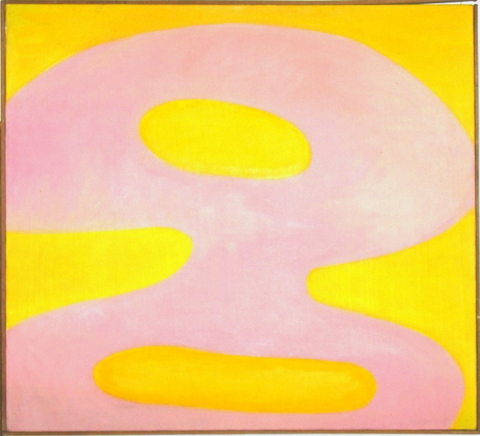
‘LOOP THE LOOP’ Oil on canvas, 27 by 30 inches, by Jean Cohen, 1973. |
A long time ago in a galaxy . . . well, it was just New York and it may seem like ancient history, but it was real life and what happened is part of who we are. We do like our stories about those days, and they quickly accrete the patina, and lack of detail, of legend.
The prevailing narrative of American art in New York in the 1950s is dominated by a few figures and a single mode — the abstraction of Pollock, de Kooning, and a small group of others whose work now populates the museums, the received history, and the stratospheric auction prices (not unconnected attributes, but that's another story). We forget, in our smug, over-determined view of history, that there were other people and other honest work being undertaken in those days.
There are two artists who began their careers then on view currently at Aucocisco Galleries in Portland: Bernard "Blackie" Langlais and Jean Cohen. Langlais died in Maine in 1977. Cohen, whose early career intersected Langlais's, lives and works on Long Island, New York.
Both were active in New York in the '50s and '60s and are among the many artists who, for sometimes inscrutable reasons, aren't part of the handful we think of from that period. They both showed in the 10th Street galleries including the artist-run Tanager and Area galleries along with Lois Dodd, Fred Mitchell, Charles DuBack, William King, and Alex Katz and many others. They were sometimes knit very close — Dodd was married to King and Cohen to Katz.
Langlais is more familiar, perhaps, for his popular animals made from recovered wood, but his early New York work was completely abstract, and it is examples of this that are currently on view. Cohen's work has rarely been seen in Maine. Bringing them together is an informal recreation of a slice of the past.
The show doesn't look at all old, or dated. Perhaps a side benefit of this otherwise uneasy era of postmodernist thought is that it has put paid to the notion that there is a historical imperative driving progressive changes in artistic modes. Artist now feel free to pursue whatever mode fits their values and sensibility, and they do. Cohen's work wouldn't look out of place in today's Chelsea or Williamsburg.
In Cohen's "Loop the Loop," an oil on canvas from 1973, an amorphous magenta curved shape rests on yellow-orange field. The shape has a "waist" that narrows from the top and bottom, dividing it into two separate but connected lobes. Ovoid shapes the color of the background rest on the magenta. The hues and borders prevent the work from being read as figure and ground; it is instead a field of color in relationship with another field of a different hue. The action of the painting takes place where the two color schemes meet.
Both areas are thin, but worked up. The yellow, for instance, has more obvious magenta (or pink, hard to say) underpainting on one side than on another. The final colors are modulated rather than modeled — these are shaped areas, not pictures of shapes. The inconsistencies, the way the canvas is cropped, and the almost relaxed boundaries between the shapes make this nothing but what it is — a painting. There's no message, no suggestion, no reference. It is simply the work of a highly skilled and experienced artist making a clear, unambiguous statement.